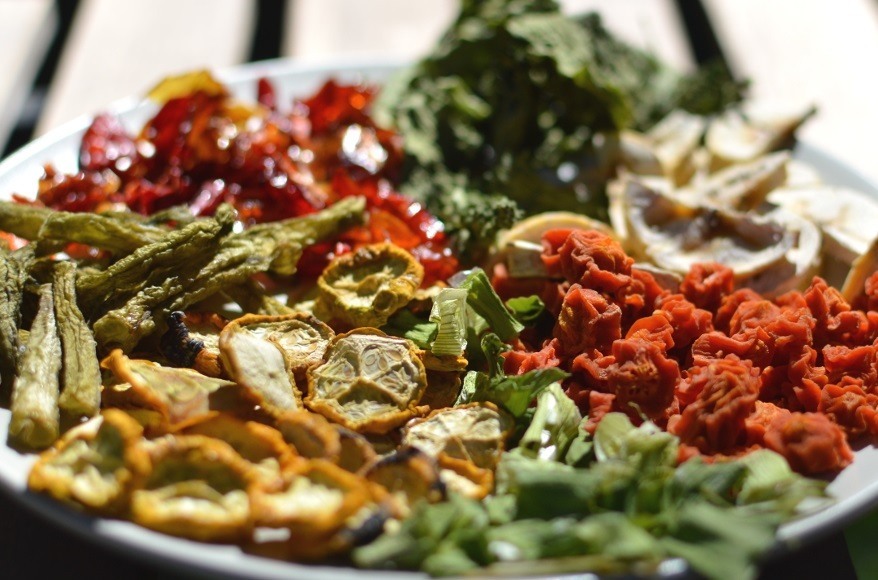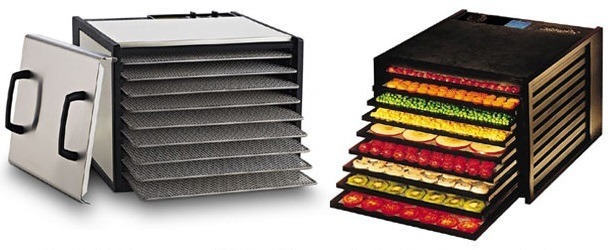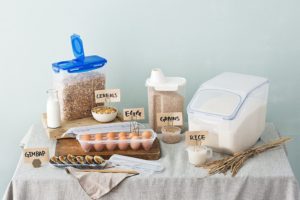If you’re going to get into dehydrating food it is best to have a few go-to food dehydrator recipes. Dehydrating food is one of the easier food preparation techniques to get into. Especially if you have a handy food dehydrator, which will help you control the drying temperature. This precision goes a long way to creating the ideal texture and taste.
On this page, readers will find some of the best food dehydrator recipes. First we will discuss the basics of food dehydration to establish a good foundation of knowledge. If you are already familiar with this process, you can skip to the dehydrator recipes section. We include jerky, fruit, vegetable, and raw food recipes.
Dehydrating Food 101
Dehydrating food is a method that has been around for centuries. Thousands of years ago, there was no such thing as freezers, refrigerators, or preservatives in food. Food was either immediately consumed, dehydrated, or salt cured. The sun was the original dehydrator. People would hang food such as meats on racks to dry in the hot sun. Many cultures favored food dehydration such as the Romans. They even constructed “still houses” whose primary purpose was to dry food in climates that did not receive ample sunlight. Large fires were constructed in these houses to create enough heat to dry food, sometimes smoking the food as well.
Food dehydration is exactly what it sounds like. It is the process of removing water (the hydration) of food. This prevents the growth of bacteria, helping food that has a relatively short shelf life stay edible for much longer. Dehydrated food takes on an entirely different form. Grapes turn to raisins, meat to jerky, and plumes to prunes. Mushrooms and other various vegetables are also sometimes dried to maintain their potency and flavor. Food dehydrator appliances provide users with much more consistent results than say drying from the sun. The temperature can be controlled and typically ranges from 130 to 180 degrees.
Though most dehydrator recipes are not overly complex, it still takes time to master the art of dehydrating. Once acquired, this skill is wonderfully useful. You’ll be able to make snacks to eat at home or on the go. Backpackers in particular will find dehydrated food useful, as the water weight of the food will be reduced making your load lighter. When you’re down to counting ounces for long journeys, every detail counts. Followers of the vegan and raw food diets will also find food dehydration useful. Since the food itself is not being significantly altered,other than losing water content, it still retains mostly all its nutrients. Electric food dehydrators help simplify the dehydrating process. This appliance is quickly growing in popularity because of its usefulness in the kitchen.
Perhaps, you are simply a do it yourself type of person. Many grocery stores overcharge for food like jerky and fruit leathers. Making this food yourself is much less expensive. You’ll also be able to do it in bulk if you have a larger food dehydrator, leaving you plenty to share with friends and family. Once you have a food dehydrator, you’re ready to go to the local grocery or market and pick up some ingredients. The last piece you’ll need is a few dehydrated food recipes. We are, of course, fully qualified and happy to supply here at ecokarma.
The following points are the main benefits of dehydrating food:
- Preservation. Perhaps the most common benefit folks choose to start dehydrating food is preservation. You’ll be able to create fresh fruit that will last up to one year by dehydrating.
- Easy and reliable. Food dehydrators are really quite simple little inventions. You’d really have to mess up to overdry food. We’re talkin’ about 12 hours mess up before you would render food inedible. They last for years before needing replaced. Heck, some people have dehydrators that are 20+ years old.
- Health. Preserving organic food that is locally grown is a great way to help maintain a healthy diet. Bodies appreciate not having artificial flavoring and preservatives from time-to-time.
- Backup Food Supply. Not everyone is planning for the end of the world, but sometimes it is nice to have some canned and dried food options if the power goes out or something like that. A little peace of mind never hurts.
Food Dehydrator Recipes
Here are the top dehydrator recipes of 2015. We compiled this list of delicious creations for beginner and seasoned food dehydrators alike. No matter what you are looking for, these timeless recipes are sure to please families and friends. We’ve come up with five main categories of dehydrated food: jerky, fruits, vegetables, spices, and grains.
Dehydrator Jerky Recipes
In this category we have recipes for dehydrator beef jerky and more. If you’re on a mission to make healthy, protein-packed snacks these recipes are for you.
- Beef Jerky Recipe Dehydrator. If your a jerky fanatic, this is the best first stop you can make. Purchase some grass beef jerky and have a hayday with this recipe. First you’ll want to slice up the beef into thin 1/4 to 1/2 inch thick strips. It helps if you meat is still thawing and slightly frozen when you have to cut it this thin. After that you’ll make the secret sauce. Here is what you’ll need for the marinade: 3 tsp sea salt, 2 tsp pepper, 1 clove of garlic, 1/4 cup chopped onions, 1/4 cup sugar, 1 tsp apple cider vinegar, 2 table spoons mesquite liquid smoke, 1/4 cup soy sauce. Mix all this up and create an awesome marinade. Find your biggest bowl and place the meat and marinade in there and cover it. Let it chill out in your fridge for about 24 hours. Now all that is left is to dehydrate. Lay the strips of meat out on your dehydrator trays. You’ll need a beef jerky dehydrator if you don’t have one already. Now, set the temp control at 150 degrees and dry for about 4 hours. You’ll be able to tell when it is done, it’ll look like dark scrumptious beef jerky. Don’t leave it in too long, or you’ll over-dehydrate it into crunchy beef crackers. You want the tender, chewy stuff. Yum!
- Salmon Jerky Recipe.
- Sweet Pork Jerky Recipe.
Dehydrated Fruit Recipes
Fruits, along with vegetables, are the most popular foods to dehydrate. There are many dehydrated fruit recipes out there. Practically every fruit you can think of you can throw in a dehydrator. The key is knowing which ones taste just as or more delicious then the original fruit. There are some fruit leather recipes that are surprisingly great tasting. You’ll need a fruit dehydrator to get the job done efficiently though. Dehydrating fruit usually is done at about 135ish degrees using parchment paper or special fruit leather inserts that come with some fruit leather dehydrators.
- Fruit Leather Recipe. The cool thing about fruit leathers is that you can get super creative. You can mix any combination of fruit to make a huge variety of tastes. Apple, blueberry,cherry, grape, kiwi,pineapple, pumpkin, raspberry, strawberry, and watermelon are just a handful of the assorted fruits you can use. You can even throw some vegetables in there if you really want to get crazy. First things first, you’ll want to wash the fruit and remove any large seeds as well as any cores. Peels are okay for the most part, if oyu want to leave them on, the contain lots of healthy nutrients. After that, you’ll want to cut the fruit into smaller pieces before you put it in the blender. Keep in mind if you want to use other flavorings and sweeteners that is optional step. These will change the composition of the fruit leather sometimes making it more sticky so be careful what you throw in there. Now start the blender. Keep blending until smooth. You want to overblend rather than underblend here. Excalibur Paraflexx sheets are perfect for drying fruit leather. Dry at 135 for about six to tweleve hours. This will depend on the juiceness level of your fruit leather recipe. Once your fruit leather is complete, store in plastic or a container in the refrigerator. Don’t leave it out or it will reabsorb moisture and may get moldy.
- Homemade Fruit Roll-ups Recipe.
- Dehydrated Grapes (Raisins) Recipe.
- Dehydrated Banana Chips Recipe.
- Dehydrated Sun Dried Tomatoes Recipe.



